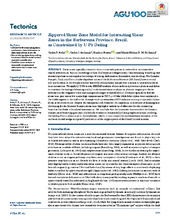Zippered Shear Zone Model for Interacting Shear Zones in the Borborema Province, Brazil, as Constrained by U-Pb Dating
Peer reviewed, Journal article
Published version

Åpne
Permanent lenke
https://hdl.handle.net/1956/21685Utgivelsesdato
2019Metadata
Vis full innførselSamlinger
- Department of Earth Science [1050]
Originalversjon
https://doi.org/10.1029/2019tc005547Sammendrag
Shear zones typically interact to form connected systems or networks to accommodate crustal deformation, but our knowledge of how this happens is fragmentary. Understanding branching and interacting shear zones requires knowledge of timing, deformation kinematics, and rheology. The Senador Pompeu, Tauá, and Cococi strike‐slip shear zones of the Borborema Province (NE Brazil) have a central role and location in the Neoproterozoic assembly of Gondwana and provide a means to understand shear zone interaction. We apply (i) U‐Pb in situ SHRIMP analysis of zircons from syntectonic plutons and dykes to constrain the timing of shearing and (ii) vorticity and strain analysis on pluton's megacrystic facies deformed in the magmatic state and during final stages of crystallization. Obtained ages show that the shear zone pair was active under high temperature at 583.5±4.6 Ma, while felsic dykes were emplaced in the brittle regime in the wall rocks. Average vorticity estimates of 0.70 indicate a strong component of pure shear in the shear zones. Despite the transpressional character, the dispersion in estimates of thinning and thickening for the Senador Pompeu shear zone highlights variations of offset rate for the interacting branches that leads to localized transtension. We conclude that the kinematic framework of the Senador Pompeu and Tauá conjugate pair involves the formation of a dextrally closing zipper structure involving the trailing Cococi shear zone to the southwest, which in turn caused the northeastward extrusion of the enclosed crustal wedge and possibly activation of the nappe system of the Ceará Central domain.